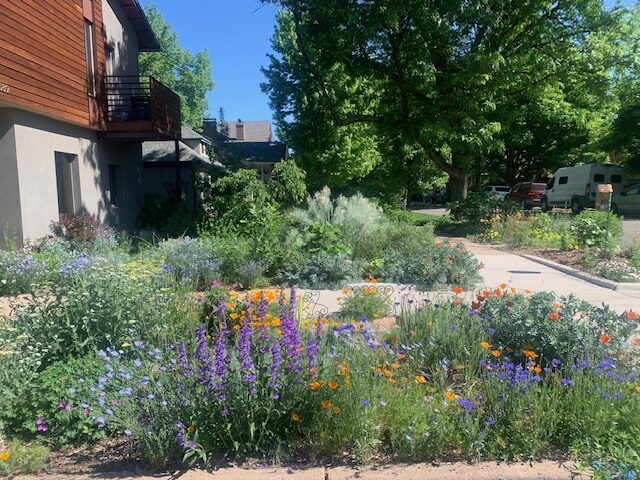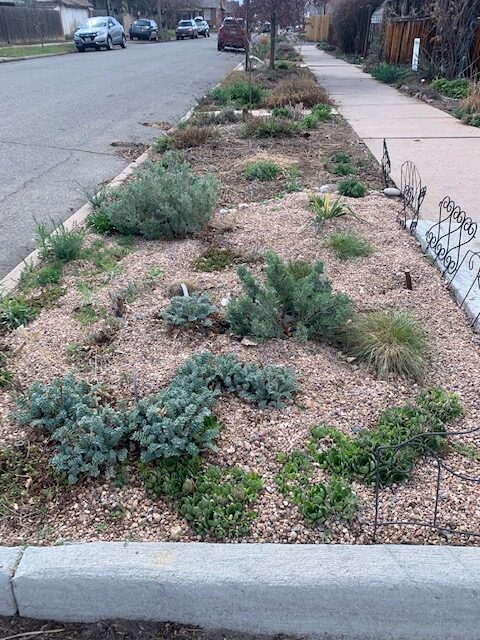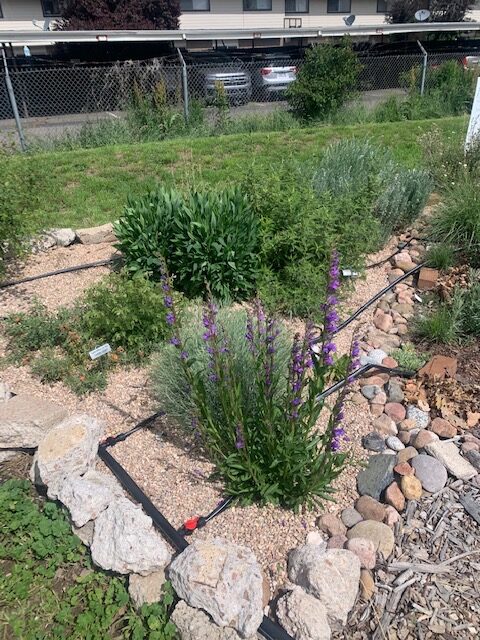By Deb Lebow Aal
Okay, it’s not the most exciting gardening article, but no doubt you have heard that mulch is important for a healthy garden. Is that true? And, mostly what we see on the Front Range is wood chip mulch. Is that the right mulch for your native plant garden?
Well, it depends. Yes, mulch is important to keep your soil healthy. And mulch can also be aesthetically pleasing, knitting your plants together. But the type of mulch you use is truly important. CSU Extension has a wonderful, comprehensive fact sheet on Mulches for Home Grounds that you should read before reading this. This article will not repeat what is in that fine fact sheet. Here, we will highlight four different types of mulch that seem to be best for native plant landscapes. Three are organic: green living mulch, leaves, and wood chip mulch. One is inorganic: gravel.
Living Mulch
In most places in Eastern Colorado, by far the best mulch you can have is green living mulch. That means no space between your plants, using the plants as your mulch. If you look at a healthy prairie ecosystem, that is what you’ll see. Shoulder to shoulder, or petal to petal, plants. And, that could be how your mature native plant garden will look. If your garden is still sparse, native annual flowers are a good intermediate solution, but before you get to that stage, there are other options.

Living mulch
Leaf Mulch
Second to green mulch is leaf mulch. Nature’s best, and for the most part, free! Nothing makes me sadder than to see leaves bagged up in plastic to be taken to the dump. Leaves provide habitat for many critters, particularly overwintering pollinators, and are the most sustainable additive you can give your plants and soil. As they break down, they add so much to the health of your yard. I have a leaf collection area in my backyard, and use it year round. I do crush my leaves (with my hands — no fancy leaf crusher machine for me), as I find they don’t blow away as easily, but, you do not have to do that. And, yes, pine needles are leaves, and contrary to popular belief, do not acidify your soil (yes — there’s scientific evidence — if they do acidify, it’s only slightly, and temporarily). They are a good mulch to use.
Wood Mulch
Then there’s wood mulch. The downside to wood mulch is that it does get hot on the surface, and absorbs moisture. So, when either nature is watering, or you are watering, some of that water does not get to the plant roots. That’s a bummer. The other disadvantage is that this is not a mulch that native prairie plants are used to, in the wild. There was not a lot of wood, or trees, in our short-grass prairie ecosystem. And the type of wood mulch you use is important. Any mulch that comes in a plastic bag is suspect. First, the plastic bag, enough said. But second, much of that mulch is dyed and treated so that it doesn’t break down fast. That is not environmentally friendly.
You may have heard that wood mulch uses nitrogen as it breaks down that would otherwise be taken up by plants. Yes, it does take up nitrogen, but the amount taken up by the wood chips is restricted to the soil surface, not the rooting zone, so don’t fret about this. Another thing to bear in mind — most native plants don’t like the wood mulch close to their crowns, so you have to make sure it is a few inches away.
Despite all these downsides, there’s nothing wrong with using wood mulch with your native plants. Wood chips are preferable to bark, and size is not insignificant — if you can, do not use the very large chips, but smaller chips (at least in places where it’s not too windy), and you do have to replenish the mulch every few years.
And gorilla-hair mulch — the very fine-looking stringy stuff that landscapers seem to prefer. Landscapers prefer it, we think, because it’s very easy to apply, and light to transport. It is terrible stuff — please don’t use it. It does not allow water to easily get through, as it knits together, forming clumps, and therefore is not doing the plants or the soil any favors. A wood chip, not too large, is preferable.

Leaf/detritus mulch area next to a gravel mulch area
Gravel Mulch
And then there’s gravel. Gravel is a fantastic mulch, but comes with some pretty hefty downsides. Gravel is a mined material, and mining has significant greenhouse gas and other environmental impacts, including significant impacts often to riparian areas. But, gravel keeps many native plants happy. It allows water to drain through much better than wood mulch, and promotes water infiltration better than wood or leaf mulch. Many of our Colorado native plants grow in the wild with a lot of rock in the soil, so it is a medium in which they have developed. There are exceptions, but for the most part, native plants do well in gravel. Aside from the significant mining and other environmental issues related to gravel, it is also hard to keep “clean,” i.e., leaf and debris free. If you like the look of clean gravel (before your plants fill in) you’ll have a bit of work to do. Particularly in shady areas, underneath trees, gravel is not a great idea. You’ll be cleaning up a lot of debris.
Landscapers prefer gravel with sharp edges, as opposed to round edged (pea gravel), which can roll, and any stone you chose should be smaller than 1/2 inch in diameter, to get the benefits. A major advantage of gravel mulch is that you don’t have to replenish often, if at all. And note, gravel mulch is not the same as gravel planting. That’s a different topic we won’t get into. If you really do want to use gravel, try looking for gravel that someone might be giving away. Reuse what is already out there.

Gravel mulch in early stage garden
Other Mulch Tips
I don’t know if I have to say this, but I will — top dress with your mulch — do not dig it in. In fact, the less you disturb your soil, the better. The mulch (even the gravel!) will make its way down into the soil. And, if you want to discourage weeds and reseeding, a depth of 4 inches of mulch is preferred. If you want some reseeding, 2-3 inches is preferable. If you don’t want to lose your mulch, create a perimeter barrier — either solid edging material to keep the mulch in (and give you a cleaner look), or digging down a bit at the edges of your plot. And, no need for landscape fabric — ever! It does not work (except for maybe the first year), and in fact is truly bad for your soil and plants.
And, despite all that we said about mulch being good for your soil, leave some bare spots for our ground-nesting native bees. We have at least 946 (by some newer reports, over 1,000) different species of native bees in Colorado (honeybees NOT being one), and many of them require bare naked soil to survive. See CSU Extension fact sheet on Attracting Native Bees to Your Landscape.
